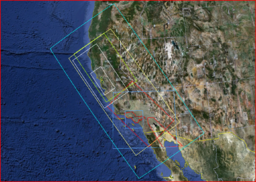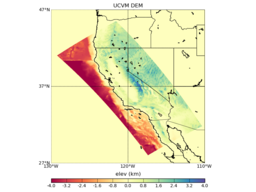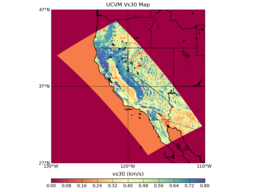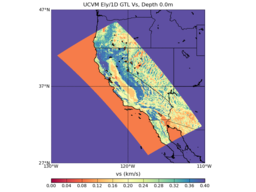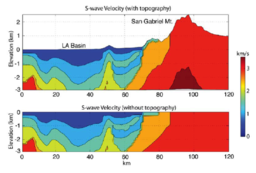UCVM 13.9.0
Contents
Introduction
Unified Community Velocity Model (UCVM) software framework is a collection of software tools designed to provide standard interface to multiple, alternative, California 3D velocity models. One important use of UCVM is in high resolution 3D wave propagation simulations for California. UCVM development is an interdisciplinary research collaboration involving geoscientists and computer scientists. UCVM geoscience research includes identification and assembly of existing California velocity models into a state-wide model and improvements to existing velocity models. UCVM computer science research includes definition of a easy-to-use CVM query interface, integration of regional 3D and geotechnical models, and automated CVM evaluation processing capabilities.
Download
| Platform | File | Download | Mirror |
|---|---|---|---|
| Linux | SCEC UCVM 13.9.0 Official Release (391 Mb) | ucvm-13.9.0.tar.gz | N/A |
| Linux | SCEC UCVM 13.9.0 md5 checksum (< 1Kb) | ucvm-13.9.0.tar.gz.md5 | N/A |
User Guide
We strongly recommend that you read through the UCVM user guide for more information on how to install and use UCVM.
Developer's Guide
Learn how to integrate your own velocity models and add other functionality to UCVM by visiting the UCVM developer guide.
What Does UCVM Include?
The following is the coverage region and projection for the included 2D elevation and Vs30 maps. The entire state of California is included, along with portions of Oregon, Nevada, Arizona, and northern Mexico.
DEM
A statewide DEM for the proposed coverage region is included within UCVM. Elevation data has been sampled from USGS NED 1 arcsec dataset (~30 m), and bathymetric data from the NOAA ETOPO1 1' dataset (~1.5 km). This DEM is currently sampled at a resolution of approximately 220m but this may be increased. The elevation data is stored as a fixed resolution Etree for the entire 1800 x 900 km region. The elevation at a particular point is smoothed using bilinear interpolation of the surrounding four elevation octants.
Vs30 Maps
Two statewide Vs30 maps for the proposed coverage region are included within UCVM:
- Wills-Wald Vs30 map (default): Vs30 data for the California landmass has been sampled from the Wills (2006) dataset at approx 0.0002197 D resolution, and out-of-state/ocean areas have been sampled from the Wald (2007) dataset at 0.0083333 D resolution.
- Yong-Wald Vs30 map (optional): Vs30 data for the California landmass has been sampled from the Yong (2011) dataset at approx 0.013 D resolution, and out-of-state/ocean areas have been sampled from the Wald (2007) dataset at 0.0083333 D resolution.
These maps are currently sampled at a resolution of approximately 220m but this may be increased. The Vs30 data is stored as a fixed resolution Etree for the entire 1800 x 900 km region. The Vs30 value at a particular point is smoothed using bilinear interpolation of the surrounding four map octants.
Geotechnical Layer
A statewide GTL for the proposed coverage region is included within UCVM. This is based on the Vs30-derived GTL method developed by Ely (2010). Interpolation between this GTL and the underlying crustal models is accomplished with the interpolation method described in that same publication. The z range over which interpolation is performed is configurable, as is the interpolation method used. The Ely method takes its input Vs30 value from the Vs30 map included within UCVM (described in the previous section).
Additionally, UCVM is able to support any number of other user-defined GTLs. It will combine them in a manner analogous to how the crustal models are combined. Each GTL may also have its own user-defined interpolation function that is used to blend it with the underlying crustal models. If no interpolation method is specified, linear interpolation is assumed.
